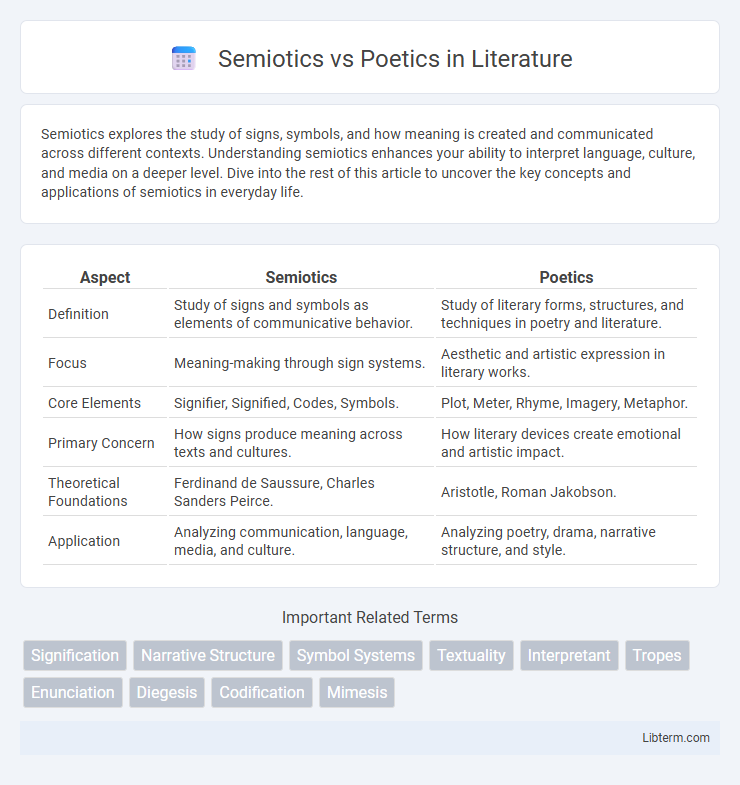Semiotics explores the study of signs, symbols, and how meaning is created and communicated across different contexts. Understanding semiotics enhances your ability to interpret language, culture, and media on a deeper level. Dive into the rest of this article to uncover the key concepts and applications of semiotics in everyday life.
Table of Comparison
| Aspect | Semiotics | Poetics |
|---|---|---|
| Definition | Study of signs and symbols as elements of communicative behavior. | Study of literary forms, structures, and techniques in poetry and literature. |
| Focus | Meaning-making through sign systems. | Aesthetic and artistic expression in literary works. |
| Core Elements | Signifier, Signified, Codes, Symbols. | Plot, Meter, Rhyme, Imagery, Metaphor. |
| Primary Concern | How signs produce meaning across texts and cultures. | How literary devices create emotional and artistic impact. |
| Theoretical Foundations | Ferdinand de Saussure, Charles Sanders Peirce. | Aristotle, Roman Jakobson. |
| Application | Analyzing communication, language, media, and culture. | Analyzing poetry, drama, narrative structure, and style. |
Introduction to Semiotics and Poetics
Semiotics examines signs and symbols as fundamental units of meaning within communication systems, focusing on the relationship between signifier, signified, and the interpretant in conveying messages. Poetics studies the principles and structures of literary and artistic expression, emphasizing how narrative and aesthetic devices generate emotional and intellectual responses. Both disciplines analyze meaning-making processes but through distinct lenses: semiotics decodes symbolic systems, while poetics explores creative construction and artistic form.
Defining Semiotics: Signs and Meaning
Semiotics explores how signs function as fundamental units of meaning within communication systems, analyzing the relationship between the signifier (form) and the signified (concept). This field distinguishes between symbols, icons, and indexes to understand how meaning is constructed and interpreted across various cultural contexts. By decoding these sign structures, semiotics reveals the underlying codes that govern the production and reception of meaning in language, art, and media.
Understanding Poetics: Structure and Aesthetics
Poetics examines the structure and aesthetics of literary works, analyzing elements such as narrative techniques, rhyme schemes, and thematic patterns that contribute to the artistic expression of texts. It emphasizes the interplay of form and content, exploring how literary devices create meaning and evoke emotional responses. Understanding poetics involves recognizing the crafted design behind storytelling and the aesthetic choices that shape a reader's experience.
Historical Development of Semiotics and Poetics
Semiotics, rooted in the works of Ferdinand de Saussure and Charles Sanders Peirce in the late 19th and early 20th centuries, evolved as a scientific study of signs and symbols as elements of communicative behavior. Poetics, originating from Aristotle's "Poetics" in ancient Greece, developed as a critical framework for understanding the principles and structures of literary and dramatic art. The historical development of semiotics emphasized the systematic analysis of meaning-making processes, whereas poetics historically focused on artistic form and expression, both fields intersecting in contemporary literary and cultural theory.
Key Theorists in Semiotics and Poetics
Semiotics, centered on theorists like Ferdinand de Saussure, Charles Sanders Peirce, and Roland Barthes, explores signs and symbols as fundamental units of meaning, emphasizing structural relationships in language and culture. Poetics, with roots in Aristotle's "Poetics" and modern developments by Russian Formalists such as Viktor Shklovsky and Roman Jakobson, analyzes literary devices, narrative techniques, and aesthetic principles shaping artistic expression. Both fields intersect in understanding meaning-making but diverge in focus: semiotics decodes sign systems across contexts, while poetics concentrates on the artifice and function of literary texts.
Fundamental Differences Between Semiotics and Poetics
Semiotics studies signs and symbols as elements of communicative behavior, focusing on how meaning is constructed and interpreted through codes and conventions. Poetics examines the aesthetic and structural principles of literary and artistic works, emphasizing the creation and analysis of form, style, and narrative techniques. While semiotics analyzes the underlying systems of meaning in any sign, poetics concentrates on the expressive qualities and artistic effects within texts.
Intersections: Where Semiotics Meets Poetics
Semiotics and poetics intersect in the analysis of signs and symbols within literary texts, where semiotics decodes meanings embedded in language while poetics explores the artistry of expression and form. This convergence enhances understanding of how narrative structures and stylistic devices convey deeper cultural and emotional significance. Examining the interplay between semiotic codes and poetic techniques reveals the multilayered construction of meaning in literature and communication.
Applications in Literary Analysis
Semiotics in literary analysis examines signs, symbols, and codes within texts to uncover deeper meanings and cultural contexts, enabling readers to interpret implicit messages embedded in narrative structures. Poetics focuses on the formal elements of literature, such as meter, rhyme, genre conventions, and narrative techniques, to analyze how these aesthetic components shape reader experience and textual meaning. Applying semiotics allows critics to decode ideological subtexts, while poetics provides tools to evaluate artistic craftsmanship and the emotional impact of literary works.
Contemporary Debates and Perspectives
Contemporary debates in semiotics and poetics examine how meaning is constructed through signs versus artistic expression. Semiotics analyzes symbols and codes in communication, while poetics emphasizes the creative and aesthetic dimensions of language. Current perspectives explore their interplay in multimedia, digital texts, and cultural narratives, highlighting the evolving boundaries between structural analysis and artistic interpretation.
Conclusion: The Future of Semiotics and Poetics
The future of semiotics and poetics lies in their increasing convergence as interdisciplinary fields, enhancing our understanding of meaning-making and creative expression across digital and multimedia platforms. Advances in artificial intelligence and cognitive science will deepen semiotic analysis, while poetics will continue to evolve through experimental narrative forms and cross-cultural dialogues. This synergy promises innovative frameworks for interpreting signs and aesthetics in a rapidly changing communicative landscape.
Semiotics Infographic

 libterm.com
libterm.com